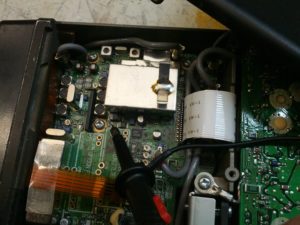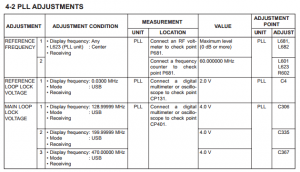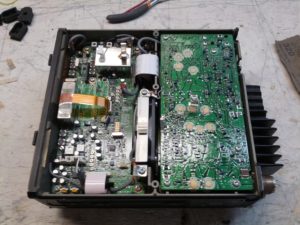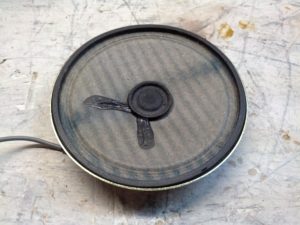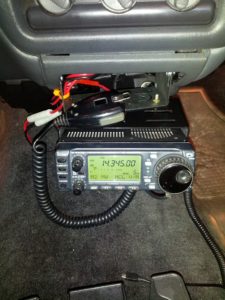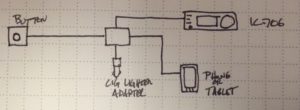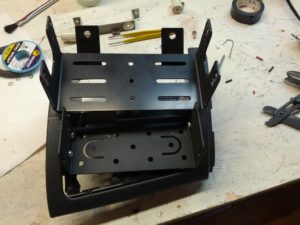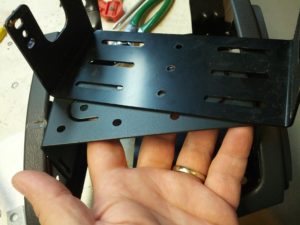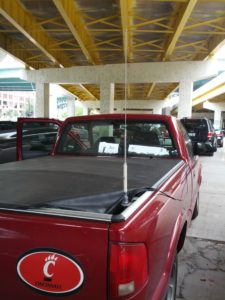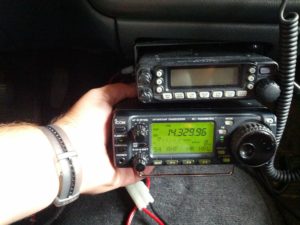Tag Archives: ic-706
For anyone on the Amateur Repairs (*cough* yahoo *cough*) group or who follows me on G+, YouTube, or Twitter, you’ve likely seen posts related to my IC-706 mkIIG. I’ve pulled the radio out of service because of problems primarily on VHF-FM (at least it seems that’s where the problems are at). In fact, since early December, I’ve been sporadic with transmitting with it, and I haven’t transmitted with it at all since mid-January.
The problem I’m having is extreme static even with very strong signals. I’ve checked the likely (hopeful?) culprits of power cords and antenna connections. Since things seem to be fine on those – I’ve tried two power cords and three power sources and two different antenna setups – I’ve moved on to checking internals.
My first check was for anything obvious. Like this, this, or even this. Nothing. I don’t know if I should say “fortunately” or “unfortunately”.
My second check was to poke around inside. I first looked at some of the audio waveforms at the NB test point and the WFM test point. Pretty interesting to see on a scope, and they didn’t react to volume (that’s a good thing, as this is likely before the audio amp!).
(PS in the video above: yes, I’m checking that with an oscilloscope probe. It works, even if it isn’t necessarily ‘right’… or maybe it is, I don’t know).
My second test was to do something more … practical. I know from some of the reading I’ve done in the ARRL Handbook, the owners and service manual for the rig, a video from Kenneth Finnegan (from The Life of Kenneth blog that I follow), and some comments from Mike M. on Google+ that maybe I should check the PLL board. And besides, checking stuff is easy, right?
The first check is the 60 MHz reference frequency. After finding and fixing a messed up power switch on my antenna analyzer and after checking it with the scope to ensure I wouldn’t blow up my analyzer, I probed it and found exactly 60.000 MHz. Good.
The second test was of the PLL Loop Lock Voltage. Initially, I found that it was around 300 mV. This was too far outside of the required 2.0 V at 0.03 MHz. I thought for a moment that it might be a typo, although those things NEVER happen…
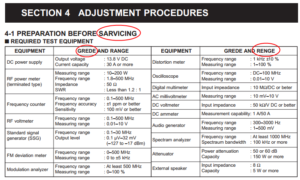
I’ve circled a few of the typos in this – not every one. Apparently I’m SARVICING this radio and I’ve been spelling GREDE and RENGE incorrectly all these years.
…and moved on to test the Main Loop Lock Voltage. It was far less than the spec 4.0 V on the first test (at 129.99999 MHz), so I didn’t continue tests.
After some replies to the post on the Amateur Repairs group, I tried again to recalibrate the PLL circuit and was able to do it. This was, of course, after I removed a shield to test two transistors. I’ve reinstalled it in the truck and so far, so good. But we’ll see. It could have been that the PLL was off causing weird errors that may have changed as voltages to the radio changed (it is mobile, after all), or it could be that something is still bad.
-73-
Update 2104-01-31
The problem came back. I tried switching out the power cable with the one I used in testing last time, and it was to no avail. At this point, I am going to do more testing to determine if this is an FM-only problem and/or if this is a VHF-only problem.
Problems
(1) Scratchy receive on 2M FM. Haven’t tested other bands or modes. Scratchy-ness sometimes goes away in a sudden fashion (like flipping a switch). It’s very much like a bad connection.
(2) Low audio volume
Potential Solutions from Research
From http://groups.yahoo.com/neo/groups/ic706/conversations/topics/17676:
Tighten chassis screws
From http://groups.yahoo.com/neo/groups/ic706/conversations/topics/14813:
“there is a known problem where the power connector is very close to a component (part of the 2m bandpass RX filter) mounted on the board. So close, that it can be knocked off the board when the power cable is plugged in or removed.”
From http://amfone.net/Amforum/index.php?topic=25009.0:
“Make sure the faceplate contacts are clean. Mine goes dead a couple times a year in my truck from this.”
From AB8SH (local friend):
Check the power connection. The Molex connector used by Icom is frequently problematic.
From unnamed (and increasingly difficult to find) posts on the IC-706MKIIG Yahoo Group:
The power connector has been mentioned multiple times on the IC-706MKIIG Yahoo Group. Additionally, the ground clips have been commonly mentioned. Frequently, these are mentioned with the 17m oscillation problem.
Reality
First thing I checked was power and ground connections. The ground clips (that should connect to the case) weren’t putting a lot of pressure on things. I bent all of them up towards the the case for good measure, although I’m not sure that fixed anything. I also ensured that all the internal screws on the PCBs were tight (all of them were).
The speaker looks aged (heck, you can see UV discoloration in the cone). Otherwise it looks fine.
After putting the rig back together, I put it on the radio bench connected to a DIFFERENT power cord and it seemed fine. A few days later, I mounted it in the truck. After driving a few miles and getting stopped at a long traffic signal, I decided to tilt the rig up more (yes, I had an appropriate Philips head screwdriver with me) and while being stopped at the light I quickly unbolted the front two mounting screws and tilted it up.
The radio died.
I (still quickly) finished bolting in the radio and while stopped at other traffic signals attempted to jiggle the power connector in the back to no avail. When I got to my destinations (another ham’s house), I found that the plug came out. In subsequent testing, it seems everything is fine.
So What Was It?
I’m banking on a bad power connection. That being said, any mobile setup should probably include proper securing of power connectors and ensuring that road vibration won’t cause things to come loose.
Edit: It is likely the power cord. I noticed static since posting this, so I’m going to replace the power cord and check the pins on the current one.
For anyone that’s been following me on Twitter, you’ve undoubtedly seen my tweets about getting some DX on 10m while mobile. For whatever reason, 10m seems to be the sweet spot with my 706 and the hamstick.
The Setup
The current setup is here (old pic)
The Issues
One issue with this is that it is difficult to control the radio. Part of it is that I need to use it more. Part of it is that it is just over an arm’s length away. Solution: I have the head separation kit, I need to mount the radio somewhere easier to see and control.
The only other issue is logging. I’ve tried using Google Keep and Evernote, but they haven’t worked very well. Keep tries to transcribe the speech, which it usually does poorly with callsigns and frequencies. It will normally get the ubiquitous “five nine”, though. I’ve decided I need an “easy button”.
So, an Easy Button. Ultimately, this will become an Android App. It’ll probably be Arduino powered. It’ll likely be open source, too.
I figure when it is plugged in, it should start an app (maybe I’ll have to do this manually). It’ll charge the Android device (hence the cigarette lighter adapter). It may run the GPS to get location when the button is pressed (I can think of a few uses for that); it would definitely get the time and date (UTC, of course!) from the phone, and it would prompt the phone to record the callsign, signal reports, and any other notes. It would also connect to my IC-706 to get the frequency and mode.
Stay tuned!
-73-
After reading Russ’s comment on last week’s post, I decided that he’s right. There’s no good reason to keep the FT-7800 in the truck when I’m installing a better, more capable radio. So it came out. Below are the gory details, all in pictures.
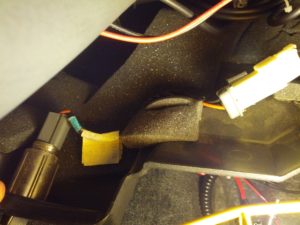
This is the reason why people like K0BG says on his website (which is the Oracle of Mobile HF) to NOT use cigarrette lighter wires – these things are around 16 gauge. Pulling 20 amps through this for an extended period of time would cause a fire.
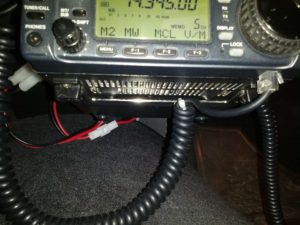
I zip-tied the mic cable to the foot on the bottom of the rig to keep from pulling too hard on the cable and damaging it. The modular cable ends are a pain to replace because the mic wire bundle is not really made for those (unlike network cable which is simple to terminate).
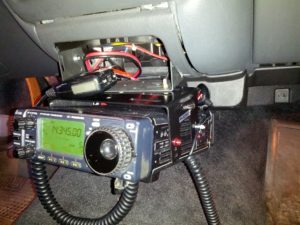
I also zip-tied my cellphone charger to the mount to keep the plug from pulling out (which I wouldn’t be able to fix while driving, obviously).
With all that said and done, all that remains is dealing with the antenna side of the equation, and removing the one below, which certainly feels like a dummy load… on a stick.
Last Friday while sitting in the parking lot of my building, I tried contacting NR4CB or AB4UG to wish them a happy wedding day. It didn’t happen. I could barely hear Connie, could tell someone was there (but couldn’t make out the words) when Eugene was on. It didn’t help that other stations were 2 kHz above and 2 kHz below.
I got to thinking about running mobile HF again.
It looks like I need to fashion a pair of brackets – one would be simple, and the other complex a little. I do have the mobile bracket for my 706, so I can always use that as a guide for holes.
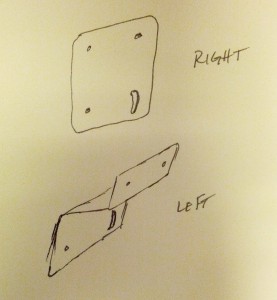
It seems far simpler when it is a sketch on a post-it note than when it is a piece of sheet metal that has to fit.
Another thought with the brackets is that I don’t *have* to have the radio there. I need the head there, but I do have the head separation kit, so I can always put the radio elsewhere and run power and antenna to it.
The other thing I looked at was the antenna. Like every other self-respecting ham, I feel as if antennas should be big. I was concerned about this 20m antenna and a quick look at K0BG’s website confirmed my suspicions.
The antenna is so small compared to 5 meters (roughly a 1/4λ for 20 meters) that it has to be basically a dummy load on a stick. I’m not sure if the bridge above me helped or hurt; I had thought about driving up to Mt. Adams, but for various reasons I couldn’t stray too far. I’ll have to try again. I need to run the antenna wire (I’m not sure other vehicles would like the idea of me having that coax flapping around, and I can’t have the tonneau cover open like it is when I’m stationary.
The last consideration is power, but it isn’t a huge consideration. I have a power line that is safe for 20 amps (as much as my 706 needs), but I don’t want to have to unhook/rehook power connectors (those ARE live, after all). I’m thinking I need a miniature power distribution center with two pair of fused power poles and a master switch, and maybe a battery shutoff.
-73-
So I spent my disposable part of the day building an RF Sampler and looking at the oscilloscope. At first I kinda got worried. I saw the image below.
So then I realized that at 20mV per division (you can’t see the pointer in the image, but it IS on 20 mV), that’s not so terrible. Especially when I look at the video below:
This was on 1V per division. So that looks okay I guess. Initially I was concerned about the distortion I was hearing on my wideband HT, but since my HT was on AM (no SSB modes available), it is probably okay.
So I’m on to looking at the antenna and feedline. Next up to build: a field strength meter.
-73-
Last March, I purchased an Icom IC-706mk2g. Since I didn’t have a power supply (and modifying my old Ten-Tec power supply is a project that is taking too long), it sat. For too long for my liking. So I put it in my truck, temporarily, to make sure it works. I had some good comments about the sound quality.
During my afternoon drive, however, I hit a few particularly nasty bumps in the road and the rig, which I had sitting on the transmission hump, slid to the side, pulling on the power and antenna connectors. After that, the comments about the sound quality dwindled to it “sounding staticy, like you’re off frequency”. I took the covers off, did some quick visual checks and didn’t see anything amiss, so I kinda passed it off.
Fast forward a few very busy months with the HF rig off, and to this past week where the 13 Colonies were on the air. Try as I might, I had a lot of trouble getting any of them. In fact, there were times I stuck it out through a pileup (trying every time they said “QRZed?”) to when they were asking “QRZed” twice and even calling CQ. I was calling out, but they weren’t hearing me.
After being heartwarmed by hearing one of the stations clear a frequency to allow a mobile station through, I thought I’d operate mobile. So I attached an antenna mount and a 20m mobile antenna to my truck. The next morning wasn’t particularly good on 20. In the afternoon, I tried hitting up the local repeater first (it had been dead in the morning, and I do like talking with my repeater friends). However, I couldn’t get through. So I tried again in a few miles. And again, a few miles after that. Finally, I could get through when I was pretty close to home. The return ID was staticy, too.
So anyway, I’m concerned for my HF rig.
-73-

